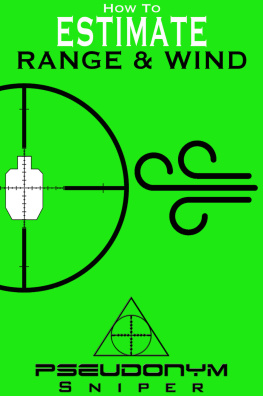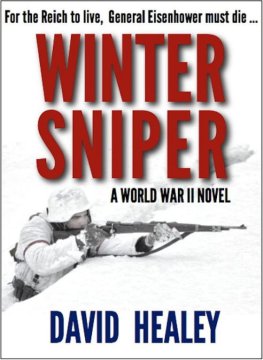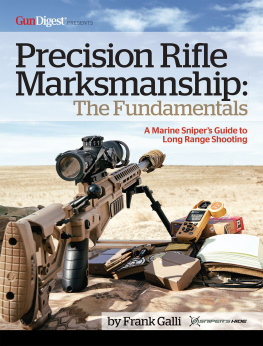Pseudonym Sniper - How to Estimate Range and Wind
Here you can read online Pseudonym Sniper - How to Estimate Range and Wind full text of the book (entire story) in english for free. Download pdf and epub, get meaning, cover and reviews about this ebook. year: 2013, publisher: eBookIt.com, genre: Home and family. Description of the work, (preface) as well as reviews are available. Best literature library LitArk.com created for fans of good reading and offers a wide selection of genres:
Romance novel
Science fiction
Adventure
Detective
Science
History
Home and family
Prose
Art
Politics
Computer
Non-fiction
Religion
Business
Children
Humor
Choose a favorite category and find really read worthwhile books. Enjoy immersion in the world of imagination, feel the emotions of the characters or learn something new for yourself, make an fascinating discovery.
- Book:How to Estimate Range and Wind
- Author:
- Publisher:eBookIt.com
- Genre:
- Year:2013
- Rating:3 / 5
- Favourites:Add to favourites
- Your mark:
- 60
- 1
- 2
- 3
- 4
- 5
How to Estimate Range and Wind: summary, description and annotation
We offer to read an annotation, description, summary or preface (depends on what the author of the book "How to Estimate Range and Wind" wrote himself). If you haven't found the necessary information about the book — write in the comments, we will try to find it.
How to Estimate Range and Wind — read online for free the complete book (whole text) full work
Below is the text of the book, divided by pages. System saving the place of the last page read, allows you to conveniently read the book "How to Estimate Range and Wind" online for free, without having to search again every time where you left off. Put a bookmark, and you can go to the page where you finished reading at any time.
Font size:
Interval:
Bookmark:
How to Estimate Range and Wind
Pseudonym Sniper
How to Estimate Range and Wind
Pseudonym Sniper
Copyright 2013 Pseudonym Sniper
All rights reserved
Published in eBook format by eBookIt.com
http://www.eBookIt.com
ISBN-13: 978-1-4566-1901-5
No part of this book may be reproduced in any form or by any electronic or mechanical means including information storage and retrieval systems, without permission in writing from the author. The only exception is by a reviewer, who may quote short excerpts in a review.
Also by Pseudonym Sniper
Marksmanship Fundamentals eBook or Paperback
Acknowledgments
First off I would like to thank my wife, who has supported me, not only in this endeavour, but who has supported me throughout my career, despite knowing that I could be leaving at a moments notice to some crisis or another.
I would also like to thank the members of our units Sniper team.
As they say, there is no I in Team, and it has been an honor to serve with all of you. I thank you all, but in particular I would like to thank TC for your advice, knowledge and experience that you have passed on.
I would also like to thank Nick, for proofing this book for me and doing his best to iron out the creases.
Cheers,
Pseudonym Sniper
Introduction
This book has been written to assist Military and Law Enforcement Snipers to not only learn, but to understand and expand their knowledge on the subjects of range estimation and allowing for environmental factors.
However, it is not limited to Military or Law Enforcement personnel, as it is also a great reference item for long range hunting enthusiasts and civilian competition shooters which is why I will use the term "shooter" throughout this book as opposed to sniper or marksman.
As such, this book will cover all relevant methods of range estimation and also includes some simple tables and diagrams that may assist the reader with understanding the methods outlined.
All relevant methods on how to make allowances for environmental factors, such as the effect of light, temperature, humidity and altitude when engaging targets at extended ranges, are also covered in this guide.
According to the Oxford Online Dictionary, to snipe is to "shoot at someone from a hiding place, especially accurately and at long range".
Wikipedia on the other hand provides the following description: "A sniper is a highly trained marksman who operates alone, in a pair, or a team who maintain close visual contact with the enemy and engages targets from concealed positions or physical distances exceeding the detection capabilities of the enemy personnel, without being detected".
Of the two, the Wikipedia definition is more in depth, and as such, I believe it to be the more accurate one. However, whichever definition you lean towards, reaching the required skill level is easier said than done.
Engaging targets at long range, whether it be in a Military, Law Enforcement or Civilian context, is one of the toughest skills to master, and it takes constant practice, in a variety of environments, for a shooter not only to become, but to remain proficient at it.
The implementation of these skills will require focus and concentration on the part of the shooter, and as such I have not written about the many other aspects of sniping in this book.
These other skills include, but are not limited to, the fundamentals of marksmanship, camouflage, stalking and tracking and also require a lot of focus, concentration and practice.
For this reason, I would rather the shooter perfect this particular skill set before moving onto another which is why I have not covered these aspects in this book.
No matter what your background, I hope this guide serves you well and helps you to achieve a higher level of proficiency.
Kind regards,
Pseudonym Sniper
Ballistics
The Basics
Before I explain to you the techniques for range estimation and how to make allowances for environmental factors, I need to cover off with you the basics of ballistics.
I say the basics because that is exactly what this will bea basic introduction to some concepts .
The subject of Ballistics could be the subject of an entire book (in fact there are several books that have been published on the subject) and so, if after reading the following section of this book, you feel the need to know more, feel free to do further reading.
If you are an experienced shooter, you may choose to skip this section and head straight to the range estimation section of this book. For the less experienced, stick with me and I'll ensure you finish up with a basic understanding of ballistics and how it can affect your fall of shot.
For those of you still with me, ballistics can be broken down into three sections or terms: Internal, External and Terminal.
Internal ballistics refers to the interior workings of a particular weapon system and how that weapon systems ammunition functions.
External ballistics refers to the flight of the bullet once it leaves the muzzle of that particular weapon system, until such time as it reaches the target.
Terminal ballistics refers to what happens to the bullet after it hits the target.
Terminology
To grasp a basic understanding of ballistics, the shooter needs to be familiar with terminology used by other shooters and other experts. The following list contains both the term and its definition:
Muzzle velocity refers to the speed of the bullet as it leaves the muzzle (the end of the barrel) and is measured in feet per second (fps). It can fluctuate due to outside influences, such as ammunition type and batch/lot number and can also be affected due to environmental factors, such as heat and humidity, which we will cover off later in this book.
Line of Sight refers to the imaginary straight line that can be drawn from the eye, through the aiming device or scope, to the point of aim.
Line of Departure refers to the imaginary straight line that can be drawn from the bore of the rifle and indicates the bullets flight path if it was not influenced by gravity, drag, etc.
Trajectory refers to the actual flight path of the bullet as it travels from the muzzle of the rifle to the intended target. As you would expect, knowing the trajectory of the bullet fired from your rifle is critically important when shooting at long ranges.
Midrange or Maximum Trajectory (aka Maximum Ordinance) refers to the highest point in the bullets trajectory/flight path on route to the target. As the trajectory/flight path is an arc, the shooter must be aware of this point as he/she may be required to shoot under an obstacle to engage the target. Failure to know the midrange trajectory may lead to the bullet striking the overhead obstacle rather than the intended target.
In Commonwealth Military States, this is often referred to as the Culminating Point.
Bullet drop refers to how far the bullet drops from the line of departure (see above) to the point at which it impacts the target.
Time of flight refers to the time taken for the bullet to travel from the rifle to the target.
Retained velocity refers to the speed of the bullet at the point of impact.
Environmental Factors Influencing Trajectory
The trajectory (see above for definition) of your bullet can be influenced by a number of Environmental factors and you must be aware of these and how they affect your bullets trajectory to ensure that your first round is on target and effective.
The most obvious factors are gravity and drag.
Gravity is a constant factor and the result is that as soon as your bullet leaves the muzzle, gravity begins to pull it towards the earth. This requires the shooter to use the elevation adjustment drum or hold over techniques to engage long range targets. At extended ranges, this may mean that the line of departure actually intersects with the light of sight, allowing the bullet to travel in an arc, with gravity bringing the bullet back down onto the intended target.
Next pageFont size:
Interval:
Bookmark:
Similar books «How to Estimate Range and Wind»
Look at similar books to How to Estimate Range and Wind. We have selected literature similar in name and meaning in the hope of providing readers with more options to find new, interesting, not yet read works.
Discussion, reviews of the book How to Estimate Range and Wind and just readers' own opinions. Leave your comments, write what you think about the work, its meaning or the main characters. Specify what exactly you liked and what you didn't like, and why you think so.













